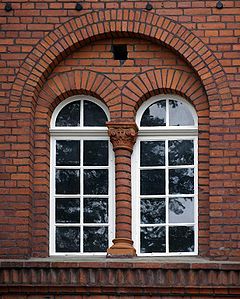Lübeck water art (1867)
| Water art Lübeck | |
|---|---|
| Data | |
| Construction year: | 1867 |
| Modification: | 1890 |
| Tower height: | 29 m |
| Usable height: | 27.4 m |
| Container type: | |
| Volume of the container: | 2145 m³ |
| Operating condition: | in operation |
| Monument protection: | Cultural monument since 1989 |
| Tower head with battlements, blind arcades, blind friezes (a so-called cross-diamond frieze found in brick Romanesque) and Lübeck coat of arms | |
| Coupled twin windows, so-called biforias in the lower area | |
The Lübeck Wasserkunst is located in the St. Jürgen district of the Hanseatic City of Lübeck directly on the Wakenitz . The central building is the water tower, which, as a historical building, takes up the language of the brick Gothic. It was built in 1867 and increased in 1890.
Medieval water arts
After calcareous water was taken from private and public wells in the early days of the city of Lübeck, water was led into the streets with a natural gradient through wooden pipes, since the amount available was insufficient. Water lifts were built, where water was lifted into the "Kummen" - a Low German expression for box or deep round bowls - by means of wheels. The largest, the brewing water art and the civil water art , stood on the Hüxterdamm in front of the Hüxtertor .
New building in 1867
Through recurring cholera epidemics , not least through the efforts of the doctor Emil Cordes , the desire to build a new water art was awakened and realized in 1867. It was a round brick building, which was divided by blind arcades, which reached over two floors and had coupled twin windows. Inside was the collection and equalization basin, a flat-bottom container with a capacity of approx. 1000 m³. A crenellated wreath completed the circular building, and a 20-meter-high riser tower rose above it, so that the water, which had been cleaned by sand filter systems, could also be directed to high-lying extraction points.
Remodeling in 1890
As more and more houses were connected to the new supply system, consumption increased steadily due to the installation of sanitary facilities and the counter pressure in the event of a fire on the market square was not sufficient to enable the use of fire engines, the building was increased and thus given to him today's shape.
Glazed bricks were used to loosen up the massive tower walls. They form strips that spiral around the central part of the tower. The tower head was equipped with plenty of blind arcades and other decorative elements, which were based on the north German brick Gothic. Instead of the original flat-bottom container, an Intze-1 container was built in . This was 10 m higher and held 2145 m³ of water. It was stored on an inner foundation that replaced the masonry of the demolished riser tower.
→ More about the container shapes in the main article water tower
Historical photos
Todays situation
The problem of quantity was solved, but not that of the water quality. The smell and taste of chlorine clouded the enjoyment, so that groundwater had to be drilled. After the commissioning of the Kleine See waterworks in 1972 and 1981 in Klein Disnack , the water was considerably improved. The water art could be put out of operation. On the site of the Wasserkunst there are today 2 pure water tanks with a total of 16,000 m³ in which water from the waterworks is stored at night in order to feed it into the Lübeck drinking water network via pumps during the day. The historic water tower also serves as a water reservoir today.
In 1989, the water art was placed under monument protection because it is "an architecturally characteristic testimony to industrial construction in the neo-Gothic style, distinctive for the local situation and as a public secular building with character of great urban significance" .
The area around the water art will in future be used for a new purpose in the form of a residential quarter. It is planned to complete the development in 2017/2018. Three streets will open up this area and refer to the historical importance. The street names are: "Alter Wasserturm", "Brunnenstube", "Zum water reservoir".
See also
literature
- Antjekathrin Graßmann (Ed.): Lübeckische Geschichte . Schmidt-Römhild, Lübeck 1988, ISBN 3-7950-3202-4 .
- Jens U. Schmidt: Water towers in Schleswig-Holstein. History and stories about the water supply in the north and its most striking buildings . Regia-Verlag, Cottbus 2008, ISBN 978-3-939656-71-5 ( Archive of German Water Towers ).
Web links
Individual evidence
Coordinates: 53 ° 51 ′ 19 ″ N , 10 ° 42 ′ 1.8 ″ E






